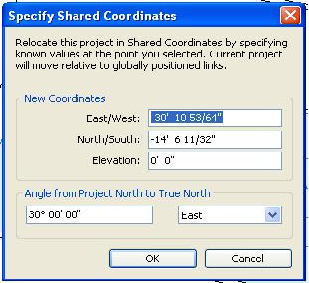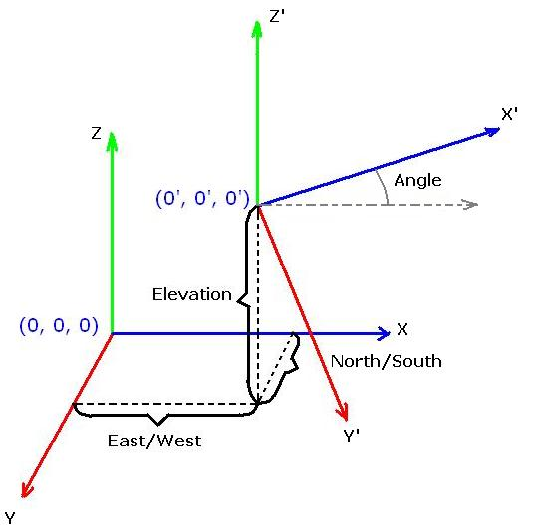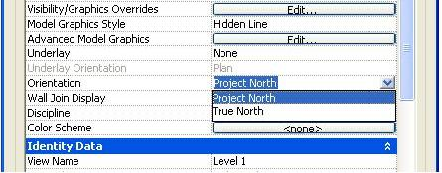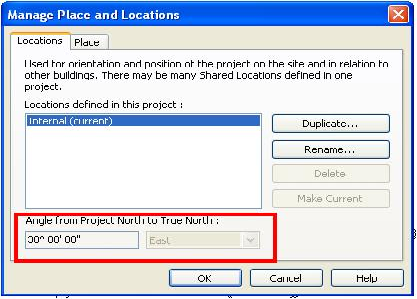Project Position
Project position is an object that represents a geographical offset and rotation. It is usually used by the ProjectLocation object to get and set geographical information. The following figure shows the results after changing the ProjectLocation geographical rotation and the coordinates for the same point. However, you cannot see the result of changing the ProjectLocation geographical offset directly.

Figure 125: Point coordinates

Figure 126: Geographical offset and rotation sketch map
The following sample code illustrates how to retrieve the ProjectLocation object.
|
Code Region 21-1: Retrieving the ProjectLocation object |
public void ShowActiveProjectLocationUsage(Autodesk.Revit.DB.Document document)
{
// Get the project location handle
ProjectLocation projectLocation = document.ActiveProjectLocation;
// Show the information of current project location
XYZ origin = new XYZ(0, 0, 0);
ProjectPosition position = projectLocation.get_ProjectPosition(origin);
if (null == position)
{
throw new Exception("No project position in origin point.");
}
// Format the prompt string to show the message.
String prompt = "Current project location information:\n";
prompt += "\n\t" + "Origin point position:";
prompt += "\n\t\t" + "Angle: " + position.Angle;
prompt += "\n\t\t" + "East to West offset: " + position.EastWest;
prompt += "\n\t\t" + "Elevation: " + position.Elevation;
prompt += "\n\t\t" + "North to South offset: " + position.NorthSouth;
// Angles are in radians when coming from Revit API, so we
// convert to degrees for display
const double angleRatio = Math.PI / 180; // angle conversion factor
SiteLocation site = projectLocation.SiteLocation;
prompt += "\n\t" + "Site location:";
prompt += "\n\t\t" + "Latitude: " + site.Latitude / angleRatio + "¡ã";
prompt += "\n\t\t" + "Longitude: " + site.Longitude / angleRatio + "¡ã";
prompt += "\n\t\t" + "TimeZone: " + site.TimeZone;
// Give the user some information
TaskDialog.Show("Revit", prompt);
}
|

Figure 127: Set orientation value in plan view Properties dialog box

Figure 128: Project is rotated 30 degrees from Project North to True North

Figure 129: Project location information
Creating and Deleting Project Locations
Create new project locations by duplicating an existing project location using the Duplicate() method. The following code sample illustrates how to create a new project location using the Duplicate() method.
|
Code Region 21-2: Creating a project location |
public ProjectLocation DuplicateLocation(Autodesk.Revit.DB.Document document, string newName)
{
ProjectLocation currentLocation = document.ActiveProjectLocation;
ProjectLocationSet locations = document.ProjectLocations;
foreach (ProjectLocation projectLocation in locations)
{
if (projectLocation.Name == newName)
{
throw new Exception("The name is same as a project location's name, please change one.");
}
}
return currentLocation.Duplicate(newName);
}
|
The following code sample illustrates how to delete an existing project location from the current project.
|
Code Region 21-3: Deleting a project location |
public void DeleteLocation(Autodesk.Revit.DB.Document document)
{
ProjectLocation currentLocation = document.ActiveProjectLocation;
//There must be at least one project location in the project.
ProjectLocationSet locations = document.ProjectLocations;
if (1 == locations.Size)
{
return;
}
string name = "location";
if (name != currentLocation.Name)
{
foreach (ProjectLocation projectLocation in locations)
{
if (projectLocation.Name == name)
{
ICollection<Autodesk.Revit.DB.ElementId> elemSet = document.Delete(projectLocation.Id);
if (elemSet.Count > 0)
{
TaskDialog.Show("Revit","Project Location Deleted!");
}
}
}
}
}
|
- The active project location cannot be deleted because there must be at least one project location in the project.
- You cannot delete the project location if the ProjectLocationSet class instance is read-only.